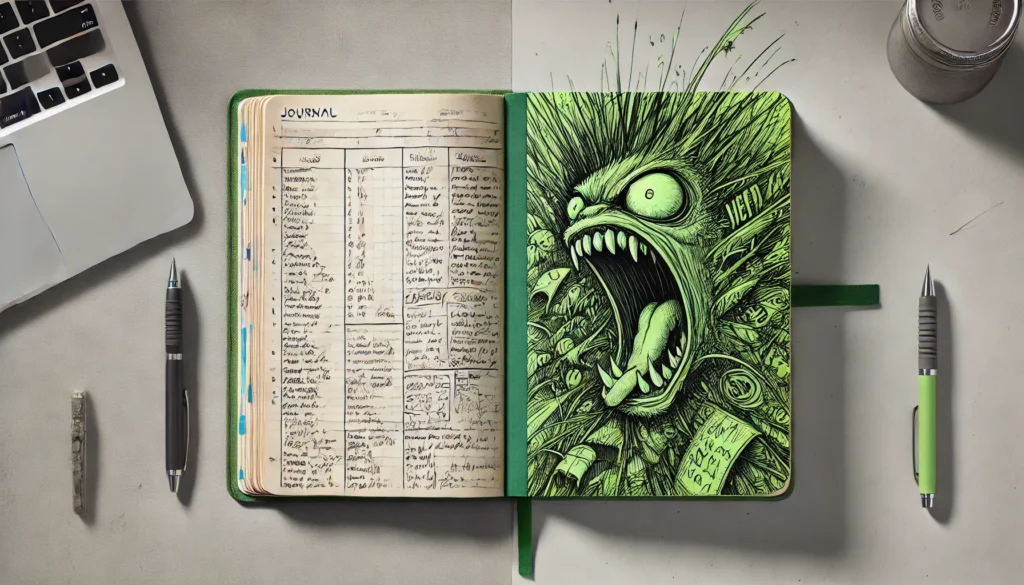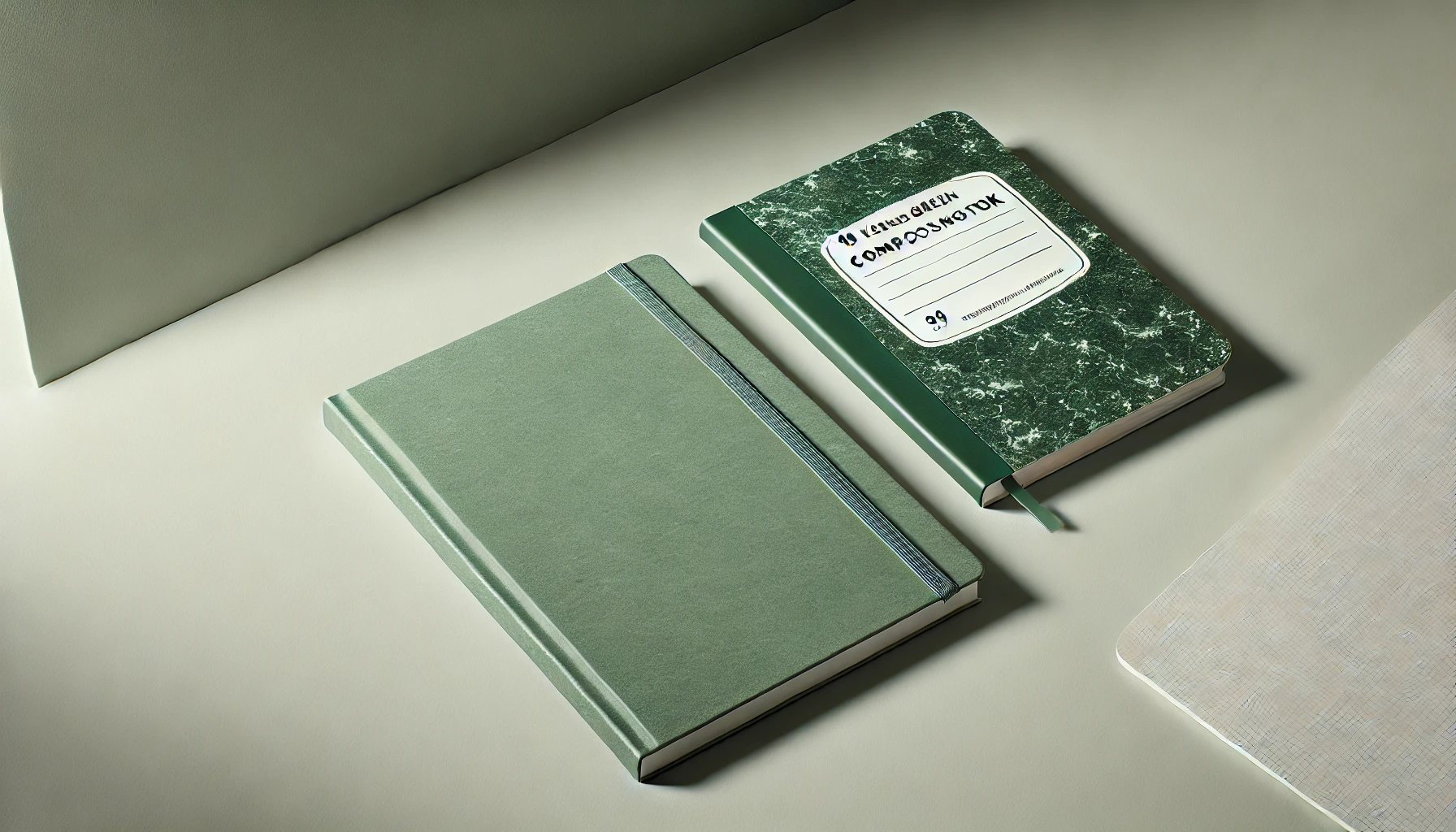My recent journey with two distinct journaling practices has revealed fascinating insights about how different forms of writing serve different purposes in our creative and emotional lives. Using both a structured stone paper journal for prompted writing and a simple notebook for free-form thoughts has created a complementary system that supports both intentional growth and raw processing.

Structured Journaling: Building the Foundation
For two years, from ages 43-44, I filled a 99-cent green composition notebook with unfiltered thoughts and raw processing. Alongside this, I maintained a stone paper journal dedicated to prompted writing from sources like School of Life’s “Know Yourself” and “Am I Normal?” cards, which served as a space for intentional self-discovery. This approach:
- Creates a framework for deeper self-understanding through guided reflection
- Helps identify and articulate core values and patterns
- Provides a legacy document that could be shared with others
- Allows for systematic exploration of identity and growth
- Functions as a reference point for tracking personal development
The structured nature of prompted journaling helps surface insights that might not emerge organically. Through this practice, I’ve been able to identify and articulate my core values: Humor, Learning, Creativity, Connection, and Prudence (the latter being more aspirational than achieved!).
Free-Form Journaling: Processing the Raw Material
The simple notebook serves a different but equally vital purpose. This space:
- Provides an outlet for immediate emotional processing
- Allows for messy, unfiltered thoughts and feelings
- Helps distinguish between fleeting emotions and deeper patterns
- Creates a safe space for working through darker thoughts
- Serves as a testing ground for insights gained from prompted writing
The unpretentious nature of a basic notebook removes the pressure to be profound or polished, allowing for more authentic expression of difficult emotions and challenging experiences.
The Synergy Between Forms
What’s most interesting is how these two approaches work together. The prompted journal helps identify patterns and insights, while the free-form journal provides space to live with and test these insights in daily life. This dual approach creates a cycle of:
- Structured reflection leading to insights
- Raw processing of how these insights play out in real life
- Further reflection on what works and what doesn’t
- Deeper integration of learning into daily experience
Impact on Creativity
This two-pronged approach has profound implications for creative work. In my case, it helped lay the groundwork for a poetry collection exploring family history and inherited patterns. The raw processing in the simple journal provided the emotional foundation, while the structured reflection helped shape these experiences into more universal themes.
Legacy and Future Impact
The different forms also serve different legacy purposes. The structured journal becomes something that could be shared with family or others, offering considered insights and reflections. The free-form journal remains private, allowing for necessary but unfiltered processing of life’s challenges.
Conclusion: The Value of Both
Rather than choosing between structured and free-form journaling, embracing both creates a more complete system for personal growth and creative development. The structure helps us find meaning, while the freedom helps us process reality. Together, they support both our internal growth and our ability to shape that growth into something meaningful we can share with others.
The key is recognizing that different types of writing serve different purposes. Creating space for each allows us to engage more fully with both our inner development and our outer expression.
Getting Started: Your Own Dual Journaling Practice
Setting Up Your Structured Journal
Choose a journal that feels special to you – whether that’s a stone paper notebook, a beautifully bound journal, or simply one that brings you joy. Then, consider exploring these three core areas:
- Core Values Exploration
- What principles guide your decisions?
- Which values did you inherit, and which have you chosen?
- How do your actions align with your stated values?
- Personal Aspirations and Growth
- What would you like to learn or master?
- Where do you see room for improvement?
- What legacy do you hope to create?
- Relationship Dynamics
- How do you show up in different relationships?
- What patterns do you notice in your connections?
- What relationships would you like to strengthen or change?
Finding Quality Prompts
Some excellent sources for structured reflection include:
- The School of Life’s card sets (“Know Yourself,” “Am I Normal?”)
- James Clear’s Annual Review questions
Embracing the Raw Journal
Now, get yourself a simple notebook – yes, that $0.99 one from the grocery store will do perfectly. This is your space for:
- Unfiltered emotional processing
- Working through difficult moments
- Capturing random thoughts and ideas
- Testing insights from your structured journal
- Writing without judgment or purpose
The beauty of this notebook is its very lack of preciousness. Let it be messy. Let it be real. Let it be a space where you don’t have to perform or polish your thoughts.
A Final Invitation
Start small. Perhaps begin with one prompt a week in your structured journal, and keep your simple notebook handy for daily thoughts. Remember, there’s no “right way” to do this – the goal is to create spaces that serve your growth and processing in different ways.
And don’t worry if it takes time to find your rhythm. Like any practice, dual journaling becomes more natural and valuable as you settle into it.
